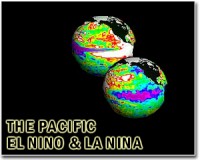| . |  |
. |
Paris (AFP) Feb 21, 2010 Weather experts say they have a tip that could give up to 14 months' warning before the onset of an El Nino, the weather anomaly that whacks countries around the Pacific and affects southern Africa and even Europe. At present, scientists are unable to give little more than a few months' notice that an El Nino is in the offing, which is often too late for farmers, fishermen and others to prepare for weather disruption. El Nino occurs every two to seven years, when the trade winds that circulate surface water in the tropical Pacific start to weaken. A mass of warm water builds in the western Pacific and eventually rides over to the eastern side of the ocean. The outcome is a major shift in rainfall, bringing floods and mudslides to usually arid countries in western south America and drought in the western Pacific, as well as a change in nutrient-rich ocean currents that lure fish. El Nino is ushered out by a cold phase, La Nina, which usually occurs the following year. Meteorologists led by Takeshi Izumo of the Research Institute for Global Change in Yokohama, Japan, believe the world can gain a precious early warning from a similar event that occurs in the Indian Ocean. This oscillation, first identified in 1999, occurs roughly every two years. Analysis of weather records from 1981 to 2009 found that when the so-called Indian Ocean Dipole was in a "negative" phase -- with the waters warm in the west and cold in the east -- an El Nino event in Pacific followed more than a year later. The driver for this pendulum appears to be a pattern in atmospheric circulation linking the two oceans, Izumo believes. The paper is published online on Sunday by the journal Nature Geoscience. In a commentary, Peter Webster and Carlos Hoyos, earth scientists at the Georgia Institute of Technology, Atlanta, said that work was needed to delve into the past. The 1981-2009 period did indeed show a "strong two-year rhythm" in which the Dipole swung along with El Nino. Other research, based on sea temperatures from 1890-2008, suggests the Indian Ocean pendulum may vary from decade to decade, the pair cautioned.
Share This Article With Planet Earth
Related Links El Nino, La Nina and an Ocean called Pacifica
 Snow, floods, heatwaves as El Nino wallops the Americas
Snow, floods, heatwaves as El Nino wallops the AmericasSao Paulo (AFP) Feb 10, 2010 Blizzards in the United States, a heatwave in Brazil, killer floods in Mexico, drought in Ecuador - according to meteorological services, freak weather being felt right across the Americas can be blamed on El Nino. The phenomenon, in which unusually hot surface temperatures along the middle of the Pacific Ocean disrupt atmospheric systems, has created storms throughout the continent and res ... read more |
|
| The content herein, unless otherwise known to be public domain, are Copyright 1995-2010 - SpaceDaily. AFP and UPI Wire Stories are copyright Agence France-Presse and United Press International. ESA Portal Reports are copyright European Space Agency. All NASA sourced material is public domain. Additional copyrights may apply in whole or part to other bona fide parties. Advertising does not imply endorsement,agreement or approval of any opinions, statements or information provided by SpaceDaily on any Web page published or hosted by SpaceDaily. Privacy Statement |